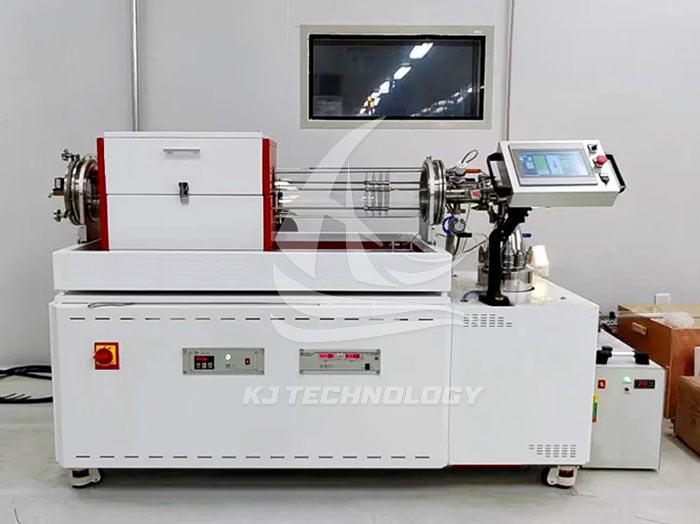Application fields of vertical graphite carbon tube vacuum furnace
 10-17-2025 Author: KJ technology
10-17-2025 Author: KJ technology
The vertical graphite carbon tube vacuum furnace plays a key role in multiple industrial fields due to its high temperature stability, efficient heat conduction, and vacuum environment control capabilities. Its core application areas and technical advantages are as follows:
1. Core application areas
semiconductor manufacturing
Monocrystalline silicon growth: By precise temperature control (error ≤± 1 ℃) and vacuum environment, high-quality monocrystalline silicon crystals are grown to avoid impurity contamination.
Annealing treatment: High temperature heat treatment of semiconductor materials to eliminate internal stress, improve mechanical strength and electrical properties.
Thin film deposition: Deposition of metal or semiconductor thin films in a vacuum environment to ensure material purity and interface quality.
Material Processing and Synthesis
Metal alloy smelting: Smelting high-purity metal alloys (such as titanium alloys and nickel based alloys), removing gas impurities, and improving material properties.
Ceramic powder sintering: Sintering ceramic powders (such as alumina and silicon nitride) in vacuum or inert atmosphere to achieve densification, improve bending strength and fracture toughness.
Nanomaterial preparation: Synthesize nanomaterials such as carbon nanotubes and graphene, and regulate the diameter distribution by controlling temperature and gas ratio.
new energy sector
Purification of battery materials: Purify negative electrode materials (such as graphite and silicon carbon composite materials), remove impurities and gases, and improve battery cycle life.
Fuel cell component processing: Sintering fuel cell electrolyte membranes or electrode materials in a vacuum environment to optimize pore structure and conductivity.
Aerospace and high-end manufacturing
Heat treatment of aircraft engine blades: Annealing the blades under argon protection to eliminate processing stress, refine grain size, and extend fatigue life.
Hydrogen removal of titanium alloy components: Hydrogen embrittlement in titanium alloys is removed through vacuum annealing, reducing the risk of fracture and ensuring the safety of spacecraft.
Laboratory research and pilot production
New material research and development: providing research institutions with high-temperature, vacuum, or inert atmosphere environments to support the exploration of new materials such as high-temperature superconducting materials and bioceramics.
Small batch production: Meet the pilot needs of universities and enterprises, verify the feasibility of processes, and reduce the risks of large-scale production.
2. Technological advantages support application
high-temperature stability
The graphite carbon tube heating element can withstand high temperatures above 2000 ℃, and is designed with a water-cooled furnace shell to ensure long-term stable operation of the equipment.
Efficient heat conduction and uniformity
Graphite material has high thermal conductivity, combined with multi-layer insulation screens, to achieve temperature uniformity within ± 5 ℃ in the furnace, meeting the requirements of precision processes.
Vacuum environment control
The combination of mechanical pump and molecular pump achieves ultra-low vacuum degree, effectively isolating active gases such as oxygen and water vapor, and avoiding material oxidation or volatilization.
Inert atmosphere compatibility
Inert gases such as argon and nitrogen can be introduced to meet different material processing requirements (such as preventing metal oxidation or promoting chemical reactions).
Structural design and durability
The vertical double-layer shell design reduces heat loss, and graphite components (such as heating pipes and bolts) are resistant to high temperatures and corrosion, extending equipment life.
3. Typical application cases
Semiconductor single crystal silicon growth: A certain enterprise uses a vertical graphite carbon tube vacuum furnace to grow single crystal silicon in a vacuum environment of 2000 ℃, with high product purity and meeting the requirements of integrated circuits.
Heat treatment of aircraft engine blades: A certain aviation manufacturing enterprise uses this equipment to perform 1100 ℃ argon protection annealing on the blades, which improves their fatigue life.
Carbon nanotube synthesis: A research institution uses equipment to catalyze the cracking of methane in an argon atmosphere at 800-1200 ℃ to synthesize high-purity single-walled carbon nanotubes.








